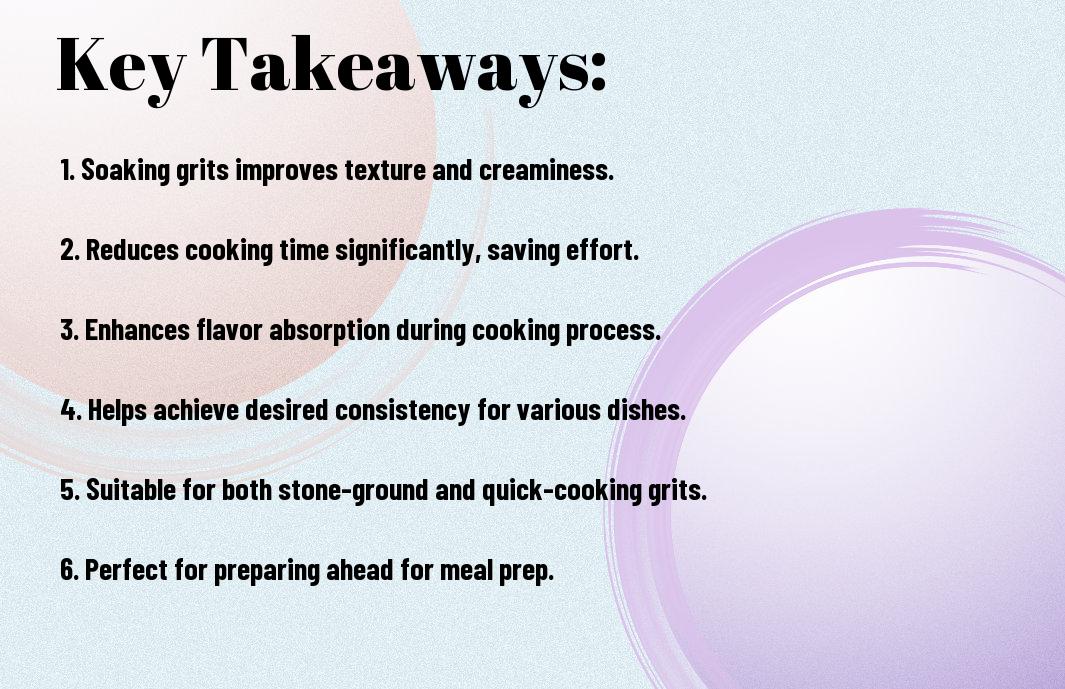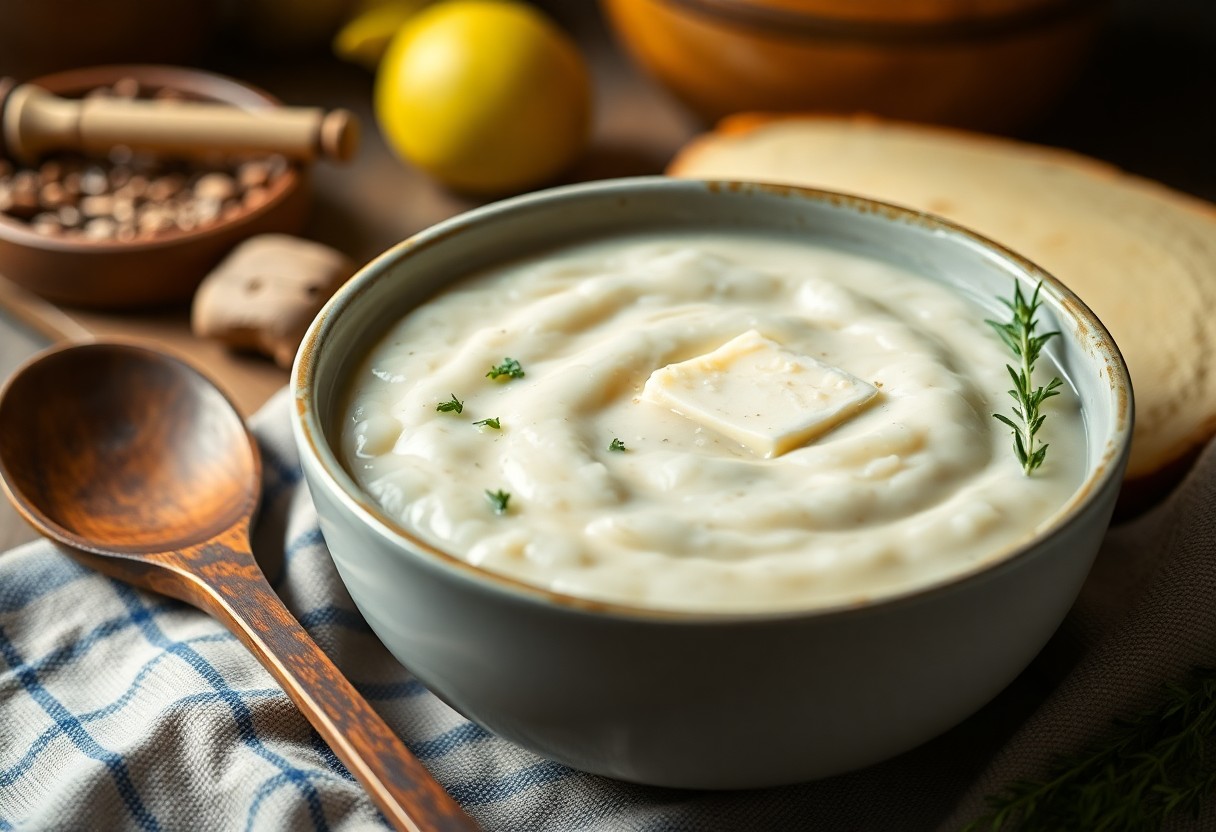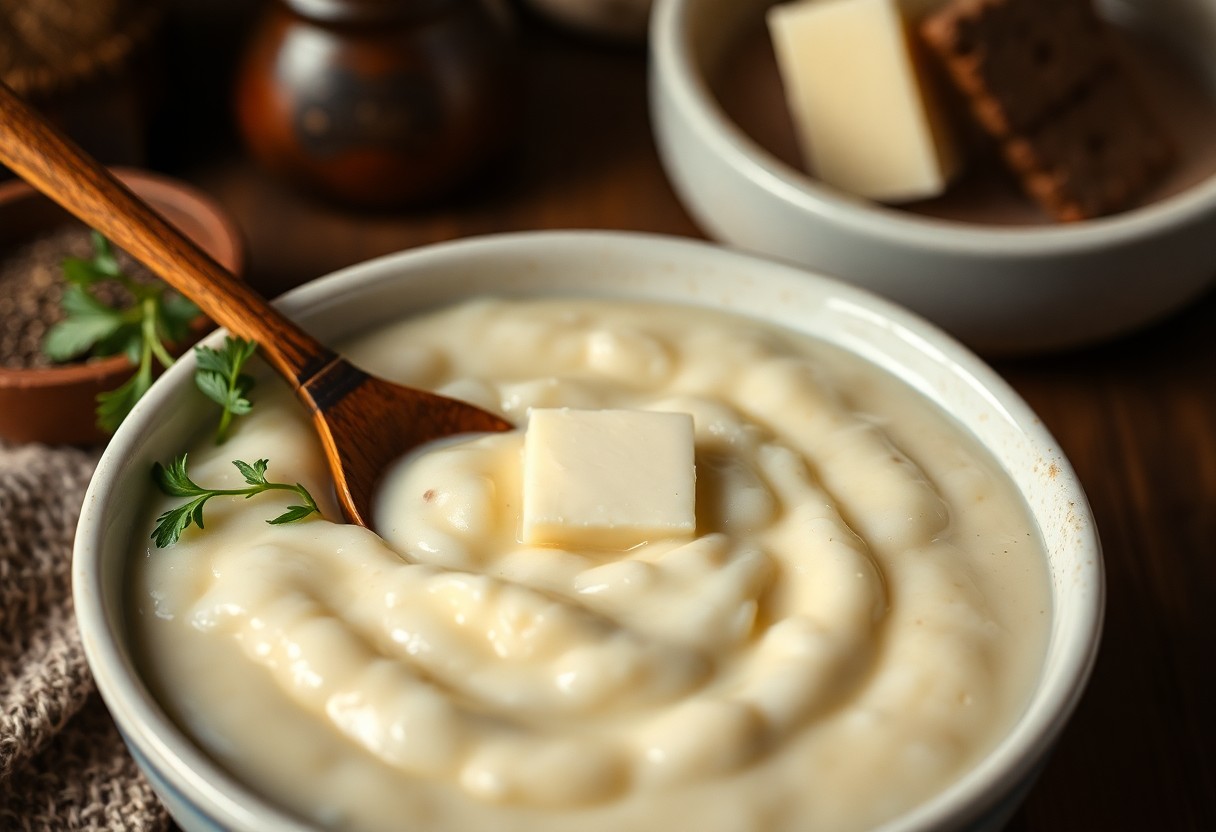With a little patience and preparation, you can elevate your grits by soaking them before cooking. This simple yet transformative technique allows the grits to absorb moisture, enhancing their texture and flavor. You’ll find that soaked grits cook faster and yield a creamier consistency, making your Southern dishes even more delightful. However, it is necessary to soak them correctly; otherwise, you risk ruining the dish. Explore how this traditional practice can improve your culinary results and add that authentic Southern touch to your meals.
Key Takeaways:
- Soaking grits before cooking can lead to a creamier texture and enhance their flavor by allowing them to absorb water and swell.
- Soaking reduces cooking time, making the preparation process quicker and more convenient for busy cooks.
- It’s beneficial to soak grits overnight to achieve optimal results, especially for stone-ground varieties, which are typically coarser than instant or quick-cooking grits.

Understanding Grits
Your appreciation for Southern cuisine begins with understanding the foundational ingredient: grits. This traditional dish, made from ground corn, is a versatile staple in Southern kitchens, often enjoyed as a side or a base for a variety of toppings. Grits can be simple or sophisticated, making them a beloved comfort food throughout the region.
What Are Grits?
Behind the simple name lies a rich history and cultural significance. Grits originated from Native American cooking, where they were often prepared as a nourishing meal. Today, they continue to be an important part of the Southern diet, offering a creamy texture and a canvas for various flavors.
Types of Grits
What you may not realize is that grits are not just a one-size-fits-all dish. Different types cater to diverse tastes and cooking methods. Here’s a breakdown of the most common varieties:
| Type of Grits | Description |
| Stone-Ground | Least processed, offers a robust flavor. |
| Instant | Quickest to prepare, but less texture. |
| Regular | Versatile and most common in recipes. |
| Quick | Cooked in about 5-10 minutes. |
| Sweet | Often used in desserts, enhances flavor. |
Even when choosing the right type, you should be aware of how each variety cooks and tastes. For instance, stone-ground grits are rich and hearty, ideal for traditional dishes, while instant grits offer convenience but lack depth. Here are key considerations:
- Cooking time: Impacts the final texture.
- Flavor profile: Influences meal pairings.
- Texture: Varies based on the type chosen.
- Origin: Regional differences may affect taste.
- Preparation method: Determines the overall dish experience.
Perceiving the differences in grits allows you to experiment and find your perfect dish, embracing the heartwarming tradition of Southern cooking.
The Soaking Process
It is vital to understand the soaking process when preparing grits. Soaking allows the grains to absorb water, breaking down their hard exterior and subsequently enhancing their texture and flavor. This simple step not only eases the cooking process but also results in a creamier dish that elevates your Southern cuisine experience.
Benefits of Soaking Grits
Any cook will tell you that soaking grits offers several advantages. It can lead to a more uniform texture and improved digestibility, allowing your body to absorb the nutrients better. Soaking also reduces the cooking time significantly, making it easier for you to whip up your favorite dish without prolonged wait.
How Long to Soak
An effective soaking time for grits typically ranges from 30 minutes to overnight, depending on your schedule. Shorter soaking times will yield decent results, but for the best taste and texture, consider soaking them overnight, ensuring they thoroughly absorb water.
Process your grits by soaking them for at least 30 minutes to achieve optimal results, but if time allows, soaking them overnight provides a significant advantage. It allows the grits to soften and expand, leading to a more flavorful and creamy texture. Be sure to use fresh, clean water for soaking, and combine this method with proper cooking techniques to unlock the full potential of your dish, ensuring it is a hit at your table.

Cooking Grits After Soaking
Many home cooks find that soaking grits transforms your dish into a creamy, decadent delight. After soaking, these little corn kernels become more pliable, allowing them to absorb water more effectively during cooking. This results in a consistency that’s *rich and velvety*. Once you’ve soaked them, you’re ready to elevate your grits into a dish that pays homage to Southern culinary traditions.
Adjusting Water Ratios
On soaking, you’ll need to adjust the water ratios for cooking. Typically, unsoaked grits require a 4:1 water-to-grits ratio, but since you’ve soaked them, you should decrease the water to around 3:1. This adjustment ensures your grits won’t turn out too watery, allowing the full flavors to shine through as you craft your delicious dish.
Cooking Techniques
Ratios play a vital role in achieving the perfect texture for your grits. You can opt for a stovetop method, bringing your grits and water to a gentle boil while stirring continuously. Alternatively, a slow cooker allows for a hands-off approach, resulting in *easy preparation*. Whichever method you choose, be sure to adjust the heat to avoid scorching—the key is to maintain a *gentle simmer*, allowing your grits to absorb the liquid fully and develop that *desired creamy consistency*.
Cooking soaked grits is about paying attention to texture and temperature. Start by bringing your mixture to a boil, then lower the heat to simmer. Stir regularly to prevent sticking and burning. For an ultimate finish, consider adding *butter or cheese* to amp up the flavor. Your soaked grits will soak up all these additional flavors beautifully, providing a *luxurious experience* with every bite.
Taste and Texture Enhancements
Despite traditional cooking methods, soaking grits can significantly improve their taste and texture. The process allows the grains to absorb moisture, leading to a more flavorful and tender final product. You’ll find that soaking grits enhances their natural flavor while also making them easier to cook, resulting in a creamy and delightful dish that stays true to Southern culinary roots.
Flavor Profiles
One great benefit of soaking grits is the depth it adds to your dish’s flavor profile. By allowing the grits to soak, you infuse them with various seasonings, aromas, and spices. This creates a richer, more satisfying experience that elevates your meal. You can even experiment with soaking in broth or milk for added flavor!
Creaminess Factors
Creaminess is a significant factor in enjoying grits, and soaking preps your dish for this delightful experience. Soaking helps the grits absorb moisture, resulting in a smoother texture. Enhance creaminess by incorporating these ingredients:
- butter
- cream
- cheese
Assume that the combination of soaking and rich additions makes every bite irresistibly creamy.
Also, be mindful of cooking times and ratios when incorporating these creaminess factors. Creaminess improves as you adjust the moisture levels and cooking method. Experimenting with ratios ensures your grits achieve the perfect consistency. Enhance your experience by considering these elements:
- multiple soak times
- liquid ratios
- whisking technique
Assume that tweaking these factors will lead to an exceptional, velvety texture you’ll crave.

Traditional Uses of Soaked Grits
For generations, soaked grits have been a staple in Southern cooking, acting as a base for a variety of dishes. This method enhances the grain’s flavor and texture, making it ideal for creamy casseroles, savory side dishes, or even breakfast. Incorporating soaked grits into your meals can elevate your culinary experience while paying homage to Southern traditions.
Grits in Southern Cuisine
Traditional Southern dishes often feature grits, a versatile ingredient loved for its ability to absorb flavors. You’ll find them in recipes ranging from shrimp and grits to cheesy grits baked to perfection. Soaked grits not only create a rich, satisfying dish but also evoke the nostalgia of Southern heritage.
Pairing Suggestions
Around the South, grits are commonly paired with a variety of ingredients, enhancing their natural creaminess. You might enjoy them alongside tangy shrimp, a hearty sausage gravy, or topped with seasonal vegetables. These combinations not only provide contrasting flavors but also enrich the overall dish.
Understanding the best ways to pair your soaked grits can transform your meal. Try serving soaked grits as a creamy base for fried catfish or grilled vegetables to create amazing flavor profiles. Adding a sprinkle of cheese, like Parmesan or Cheddar, gives your dish a delightful twist. You can also consider garnishing with fresh herbs to brighten up the flavors. Experimenting with these pairings will enhance your cooking and leave your taste buds satisfied.
Common Mistakes to Avoid
All great Southern cooks have one thing in common: they learn from their mistakes. As far as soaking grits, there are a few pitfalls you should avoid to ensure your dish turns out perfectly every time.
Over-Soaking
An important tip for soaking grits is to avoid over-soaking them. Soaking grits for too long can lead to a mushy texture, making it difficult to achieve that authentic Southern consistency you crave.
Improper Cooking Methods
For perfectly cooked grits, using improper cooking methods can ruin your dish. Your goal should be to strike a balance between soaking and cooking times to achieve the right texture.
The key to cooking grits effectively lies in your method. Using high heat can cause the grits to clump, leading to an uneven texture. Instead, cook your grits over low to medium heat, stirring frequently to ensure they are creamy and smooth. Additionally, rushing the cooking process will yield undercooked or inconsistently textured grits. Taking your time allows the flavors to develop, giving you a delicious, authentic dish that’s the hallmark of Southern cooking.
Final Words
The key to elevating your grits lies in soaking them before cooking. When you soak your grits, you allow them to absorb water, resulting in a creamier texture and enhanced flavor. This simple step can transform your dish, making your southern cooking even more impressive. By taking the time to soak your grits, you ensure a delightful experience with each bite, showcasing the rich tradition of southern cuisine. So, the next time you prepare grits, don’t skip this important step for optimal results.
FAQ
Q: What happens to grits if you soak them overnight?
A: Soaking grits overnight allows them to absorb water, which can lead to a creamier texture once cooked. This method can also reduce the overall cooking time, as the grits will be partially hydrated. Additionally, soaking can enhance the flavor as the grains have more time to interact with the water.
Q: Do I need to soak grits before cooking them?
A: Soaking is not a requirement when cooking grits, but it can enhance the final dish. If you’re short on time, you can skip the soaking. However, if you soak them, they may cook more evenly and achieve a smoother consistency, making the dish more enjoyable.
Q: Can you soak instant grits in water?
A: Soaking instant grits is not necessary since they are designed to cook quickly. Instant grits are processed to absorb water rapidly, and soaking them could lead to mushiness. For the best results with instant grits, simply add boiling water or milk directly and stir.
Q: Will soaking grits change their flavor?
A: Soaking grits can subtly enhance their flavor as the grains absorb water, which allows them to become more integrated with seasonings and any other ingredients you may add during cooking. While the flavor change might be minimal, some people find that it improves the overall taste profile of the dish.
Q: Are there any downsides to soaking grits?
A: While soaking grits has its benefits, there are a couple of potential downsides. If left to soak too long, grits can become overly soft or even waterlogged, which may result in a mushy texture when cooked. Additionally, soaking may require extra planning in advance, which might not be convenient for everyone’s cooking schedule.
